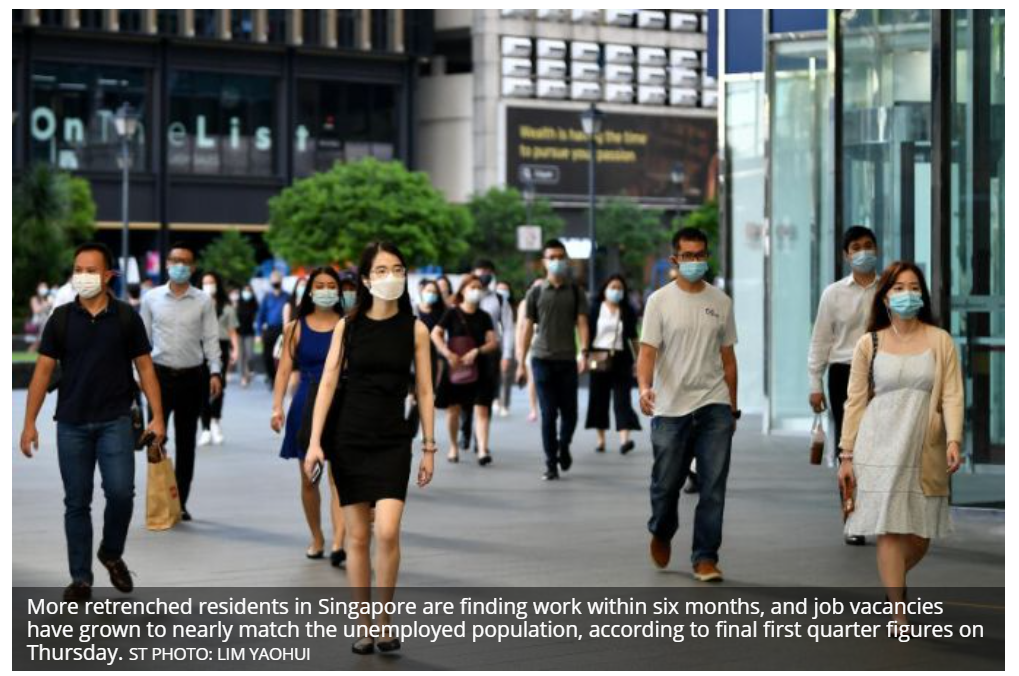Singapore: Re-entry rate of retrenched workers up, job vacancies grew in first quarter
MORE retrenched residents in Singapore are finding work within six months, and job vacancies have grown to nearly match the unemployed population, according to final first quarter figures on Thursday, which also showed that total employment grew by more than initial estimates.
The latest Labour Market Report, which follows advance estimates out in April, affirms the earlier assessment that the labour market is on the path to recovery, said Manpower Minister Tan See Leng in a media doorstop.
Nonetheless, he reiterated warnings that this path “will not be a straight road”, with twists and potential roadblocks including the tightened Covid-19 community measures in May.
“Recovery is also expected to be more uneven across sectors than earlier expected,” he added. While the Phase 2 (Heightened Alert) period may have affected the domestic-oriented sectors, the government is “cautiously optimistic” about the external sector, with “quite a lot of good news” on the manufacturing front.
Total employment grew by 12,200 in the first quarter – revised up from an earlier 4,800 estimate – after four straight quarters of decline.
The upward revision was due to resident employment rising more than expected, up by 23,700. This more than made up for the 11,500 decline in non-resident employment, which permanent secretary for manpower Aubeck Kam said “partly reflects the restrictions on the inflow of foreign workers due to public health reasons”.
“The ongoing border restrictions to reduce Covid-19 importation risks will continue to put significant pressure on foreign employment growth, particularly for the manpower-heavy sectors like construction,” said Mr Kam.
“The decline in foreign employment is cyclical and not structural, and we do expect the number of foreign workers to grow at some point,” he added.
There were 2,270 retrenchments in the first quarter, marking the second straight quarter of decline, though this was slightly higher than the initial estimate of 2,100.
Unemployment rates continued to improve as of March, though remaining elevated compared to pre-Covid levels, at 2.9 per cent overall; 4 per cent for residents; and 4.2 per cent for citizens.
A separate release earlier in June showed that in April, resident and citizen unemployment rates fell further to 3.9 per cent and 4.1 per cent respectively, while the overall rate was unchanged.
New figures in Thursday’s report include job vacancies, which rose for the third straight quarter to 68,400 in March. The industries with the most vacancies were manufacturing (8,900), public administration and education (8,200), and construction (6,500).
The ratio of job vacancies to unemployed persons approached parity, at 0.96, up from 0.75 in December. This compares with a pre-Covid range of 0.82 to 1.09 in 2018 and 2019.
Asked if there might be some mismatch between vacancies and unemployed persons – particularly in industries such as construction, which face a labour crunch amid entry restrictions on foreign workers – Dr Tan said that while there will always be some mismatch, the re-entry rate for retrenched residents is promising.
More retrenched workers were finding work within six months, with this re-entry rate improving for the second straight quarter to 66.2 per cent, up from 64.3 per cent before.
The number of employees placed on short work-week or temporary layoff arrangements also continued to fall, halving from 8,710 in the fourth quarter of 2020 to 4,020 in the first quarter.
This was down sharply from the peak of 81,720 in Q2 2020, though still high compared to the average pre-pandemic level of 740 in 2018 and 2019.
Advance estimates for the labour market in the second quarter are due to be released in late July.
Source: https://www.businesstimes.com.sg/government-economy/re-entry-rate-of-retrenched-workers-up-job-vacancies-grew-in-first-quarter


 Thailand
Thailand




